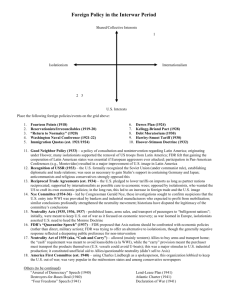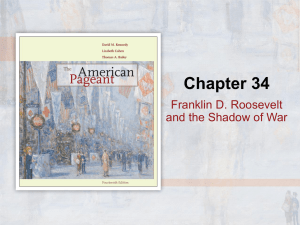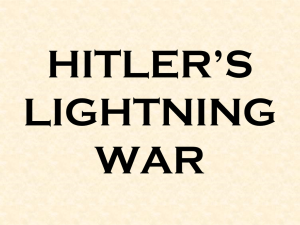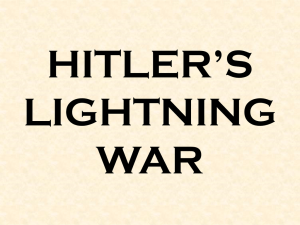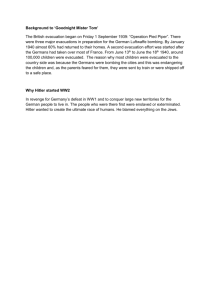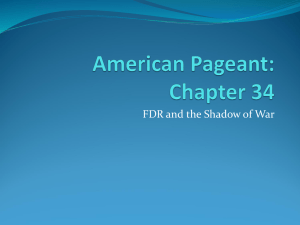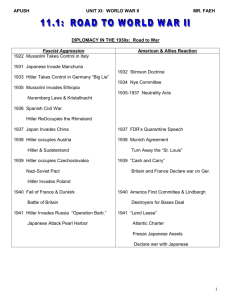APUSH25 - Foreign Policy Between the World Wars
advertisement
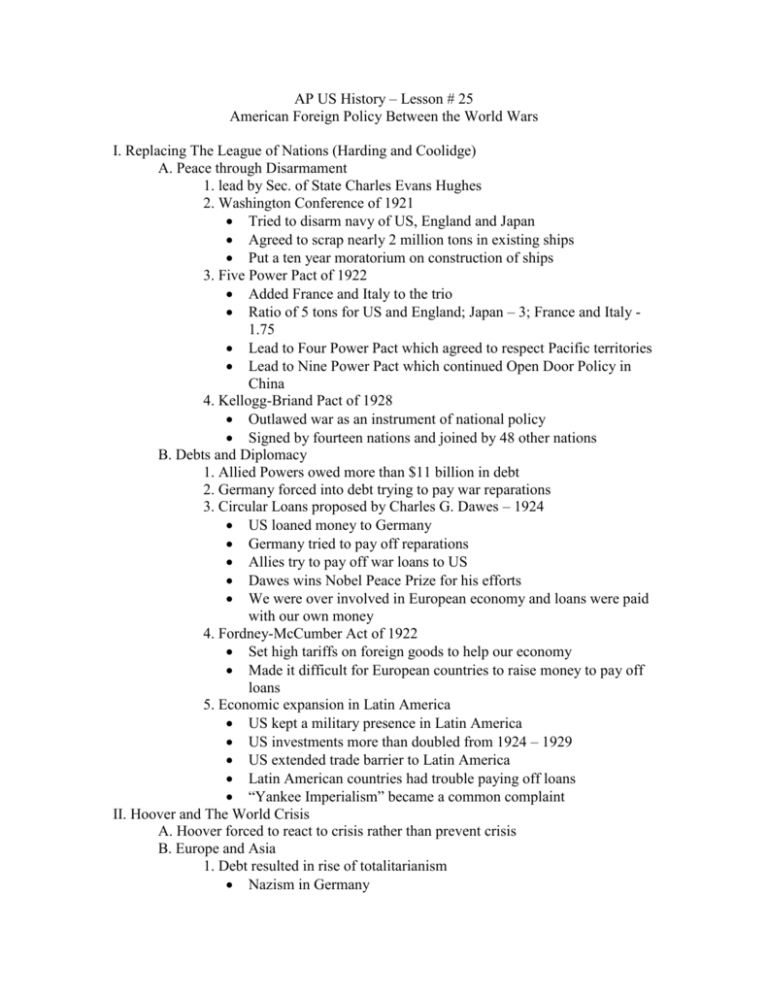
AP US History – Lesson # 25 American Foreign Policy Between the World Wars I. Replacing The League of Nations (Harding and Coolidge) A. Peace through Disarmament 1. lead by Sec. of State Charles Evans Hughes 2. Washington Conference of 1921 Tried to disarm navy of US, England and Japan Agreed to scrap nearly 2 million tons in existing ships Put a ten year moratorium on construction of ships 3. Five Power Pact of 1922 Added France and Italy to the trio Ratio of 5 tons for US and England; Japan – 3; France and Italy 1.75 Lead to Four Power Pact which agreed to respect Pacific territories Lead to Nine Power Pact which continued Open Door Policy in China 4. Kellogg-Briand Pact of 1928 Outlawed war as an instrument of national policy Signed by fourteen nations and joined by 48 other nations B. Debts and Diplomacy 1. Allied Powers owed more than $11 billion in debt 2. Germany forced into debt trying to pay war reparations 3. Circular Loans proposed by Charles G. Dawes – 1924 US loaned money to Germany Germany tried to pay off reparations Allies try to pay off war loans to US Dawes wins Nobel Peace Prize for his efforts We were over involved in European economy and loans were paid with our own money 4. Fordney-McCumber Act of 1922 Set high tariffs on foreign goods to help our economy Made it difficult for European countries to raise money to pay off loans 5. Economic expansion in Latin America US kept a military presence in Latin America US investments more than doubled from 1924 – 1929 US extended trade barrier to Latin America Latin American countries had trouble paying off loans “Yankee Imperialism” became a common complaint II. Hoover and The World Crisis A. Hoover forced to react to crisis rather than prevent crisis B. Europe and Asia 1. Debt resulted in rise of totalitarianism Nazism in Germany Fascism in Italy Nationalism in Japan 2. Proposal to put moratorium on war debts but failed 3. World Disarmament Conference of 1932 attempt to continue reduction in arms is thwarted by rise of Germany France recommends international army to check Germans Conference ends in failure 4. Manchuria Moderate government in Japan fails in 1932 Japan launches a major offensive into Manchuria America offered threats but failed to support League of Nations C. Latin America 1. Set off on a ten-week goodwill tour to improve relations 2. Tried to prevent military interventions and even repudiated Roosevelt Corollary of Monroe Doctrine 3. Agreed to except new governments without questioning their means 4. Latin American countries still forced to default on loans III. FDR toys with Neutrality A. FDR’s “bombshell” 1. America was to join in World Economic Conferences in 1933 3. FDR refused to settle the war debt though international agreement 4. Forbade American banks from giving loans to nations in default B. Reciprocal Trade Agreement Act – 1934 1. Negotiated reducing tariffs as much as 50% 2. Cordell Hull negotiated 21 new treaties by 1939 3. Increased American exports by nearly 40% C. Good Neighbor Policy in Latin America 1. Increased trade with Latin America by over 100% 2. Inter-American Conference agreed that no nation had the right to intervene into the affairs of another – 1933 3. Used economic influence instead of military influence D. The Neutrality Acts 1. 1935 – mandatory arms embargo on counties involved in military conflict (prevent involvement in Italy’s invasion of Ethiopia) 2. 1936 – renewed provisions above 3. 1937 – created Cash and Carry plan where countries could only purchase non-military goods and they had to carry them on their own ships E. Quarantine Speech on Manchuria raises objections with isolationists IV. From Neutrality to Interventionism - Europe A. The Failure of Munich 1. 1936 – Hitler sends German army into the Rhineland 2. March, 1938 – Hitler invades Hungary and proclaims a union between Germany and Austria (Anschluss) 3. Sept., 1938 – Hitler enters the Sudetenland, Czechoslovakia to acquire Lebensraum (room to expand) 4. Sept. 29, 1938 – Munich Conference Hitler meets with leaders of France and England Allies agree to accept German expansion Hitler agrees to expand no further Chamberlain says, “ peace in our time” B. Failure of Appeasement 1. Munich was classic example of Hitler out maneuvering Allies 2. March, 1939 – Hitler takes over rest of Czecholovakia 3. April, 1939 – Hitler makes threats to take Poland 4. Sept., 1939 – Hitler invades Poland 5. Poland, England and France declared war on Germany C. America makes steps towards war 1. Sept. 1939 – revises Neutrality Acts allows Allies to purchase arms on cash and carry basis 2. March, 1940 – Soviet Union takes over Baltic countries 3. Spring, 1940 – Hitler invades Netherlands, Belgium, Denmark, Norway 4. May 16, 1940 – Congress authorizes $1 billion for defense 5. June, 1940 – Hitler enters France and is supported by Italy 6. June 22, 1940 – Hitler enters Paris and sets up Vichy government 6. Summer and Fall, 1940 – Committee to Defend America opposes America First Committee 7. Nov. 1940 -FDR agrees to run for a third term and defeats Wendell Willkie 8. Dec. 1940 – America begins Lead-lease Policy to help England 9. July, 1941 – American ships patrol North Atlantic to protect convoys 10. August, 1941- Atlantic Charter was signed Chuchill and FDR met secretly to agree on support of war effort Agreed on Four Freedoms (speech, religion, want and fear) 11. Fall, 1941 – German breaks non-Aggression pact and invades Russia V. From Neutrality to Interventionism – Asia A. July 7, 1937 – Japan and China clash on Marco Polo Bridge B. Summer, 1937 – Japan overruns southern China (Nanjing Massacre) C. China was involved in its won civil war Chinese nationalist led by Chiang Kai-Shek Chinese communist led by Mao Zedong Agree to truce in 1937 to fight Japan D. Reasons for Japan’s increased militarism Military generals were taking control of more moderate politicians Japan had a need for raw materials to handle their expanding population Japan dependent on America for oil and steel When Japan invades China, US threatens to put embargo on oil Japan decides to expand throughout pacific Islands to acquire oil E. Sept. 1940 – Japan signs Tripartite treaty with Italy and Germany F. July, 1941 – Japan moves into Indochina and takes over Vietnam G. Japan threatens to move into Dutch West Indies and US enforces a complete embargo H. Japanese Prince Konoye tries to negotiate a peace with US I. Oct., 1941 – Military replaces Konoye with General Hideki Tojo J. America had decoded the Japanese code and knew an attack was imminent K. Most thought the attack would occur against Dutch or British territories in Pacific L. 7:55 AM, Dec. 7, 1941 – Japan attacks Pearl Harbor Japanese attack was a complete success US loses 8 battleships, 3 cruisers, 4 other vessels, 188 airplanes, 2,000 soldiers were killed, and 1,000 soldiers were injured M. Dec. 8 – FDR delivers war message to Congress – “a date that will live in infamy.” L. Dec. 11 – Germany and her allies declared war on the United States

